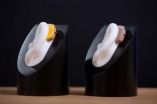(Press-News.org) Playing a science-based mobile gaming app for 25 minutes can reduce anxiety in stressed individuals, according to research published in Clinical Psychological Science, a journal of the Association for Psychological Science.
The study suggests that "gamifying" a scientifically-supported intervention could offer measurable mental health and behavioral benefits for people with relatively high levels of anxiety.
"Millions of people suffering from psychological distress fail to seek or receive mental health services. A key factor here is that many evidence-based treatments are burdensome — time consuming, expensive, difficult to access, and perceived as stigmatizing," says lead researcher Tracy Dennis of Hunter College. "Given this concerning disparity between need and accessibility of services, it is crucial for psychological researchers to develop alternative treatment delivery systems that are more affordable, accessible, and engaging."
That's where the mobile app comes in.
The game is based on an emerging cognitive treatment for anxiety called attention-bias modification training (ABMT). Essentially, this treatment involves training patients to ignore a threatening stimulus (such as an angry face) and to focus instead on a non-threatening stimulus (such as a neutral or happy face). This type of training has been shown to reduce anxiety and stress among people suffering from high anxiety.
In the study, about 75 participants — who all scored relatively high on an anxiety survey — were required to follow two characters around on the screen, tracing their paths as quickly and accurately as possible.
After playing the game for either 25 or 45 minutes, the participants were asked to give a short speech to the researchers while being recorded on video — an especially stressful situation for these participants.
The videos revealed that participants who played the ABMT-based version of the game showed less nervous behavior and speech during their talk and reported less negative feelings afterward than those in the placebo group.
"Even the 'short dosage' of the app — about 25 minutes — had potent effects on anxiety and stress measured in the lab," explains Dennis, who co-authored the study with Laura O'Toole of The City University of New York. "This is good news in terms of the potential to translate these technologies into mobile app format because use of apps tends to be brief and 'on the go.'"
The researchers are currently investigating whether even shorter stints of play – similar to how we normally play other smartphone games — would have the same anxiety-reducing effect.
"We're examining whether use of the app in brief 10-minute sessions over the course of a month successfully reduces stress and promotes positive birth outcomes in moderately anxious pregnant women," Dennis says.
While it's unclear whether this app would produce mental health benefits in those with clinically-diagnosed anxiety, it does present a compelling case for gamified ABMT acting as a "cognitive vaccine" against anxiety and stress. The researchers believe that apps could eventually be developed to assist in the treatment for other mental health disorders, such as depression or addiction.
"Gamifying psychological interventions successfully could revolutionize how we treat mental illness and how we view our own mental health. Our hope is to develop highly accessible and engaging evidence-based mobile intervention strategies that can be used in conjunction with traditional therapy or that can be 'self-curated' by the individual as personal tools to promote mental wellness," Dennis concludes.
INFORMATION:
This research was supported by the National Institute of Mental Health and the National Institute on Minority Health and Health Disparities.
For more information about this study, please contact: Tracy A. Dennis at tracy.dennis@hunter.cuny.edu.
The article abstract is available online: http://cpx.sagepub.com/content/early/2014/03/06/2167702614522228.abstract
For a copy of the article "Mental Health on the Go: Effects of a Gamified Attention-Bias Modification Mobile Application in Trait-Anxious Adults" and access to other Clinical Psychological Science research findings, please contact Anna Mikulak at 202-293-9300 or amikulak@psychologicalscience.org.
Reducing anxiety with a smartphone app
2014-03-18
ELSE PRESS RELEASES FROM THIS DATE:
Only 1 fifth of people with hearing problems wear a hearing aid
2014-03-18
Just a fifth of people with hearing problems wear a hearing aid, a study by The University of Manchester has found.
The study, published in the journal Ear and Hearing, looked at the habits of 160,000 people in the UK aged 40 to 69 years. It found 10.7 per cent of adults had significant hearing problems when listening to speech in the presence of background noise - but only 2.1 per cent used a hearing aid.
One in 10 middle aged adults had substantial hearing problems and were more likely to be from a working class or ethnic minority background.
Dr Piers Dawes, from ...
Scent of the familiar: You may linger like perfume in your dog's brain
2014-03-18
An area of the canine brain associated with reward responds more strongly to the scents of familiar humans than it does to the scents of other humans, or even to those of familiar dogs.
The journal Behavioural Processes published the results of the first brain-imaging study of dogs responding to biological odors. The research was led by Gregory Berns, director of the Center for Neuropolicy at Emory University.
"It's one thing when you come home and your dog sees you and jumps on you and licks you and knows that good things are about to happen," Berns says. "In our experiment, ...
Analysis of 50 years of hit songs yields tips for advertisers
2014-03-18
Researchers from North Carolina State University have analyzed 50 years' worth of hit songs to identify key themes that marketing professionals can use to craft advertisements that will resonate with audiences.
"People are exposed to a barrage of advertisements and they often respond by tuning out those advertisements. We wanted to see what we could learn from hit songs to help advertisers break through all that clutter," says Dr. David Henard, a professor of marketing at NC State and lead author of a paper describing the research. "We also wanted to see if there were ...
Rats' brains may 'remember' odor experienced while under general anesthesia
2014-03-18
Rats' brains may remember odors they were exposed to while deeply anesthetized, suggests research in rats published in the April issue of Anesthesiology.
Previous research has led to the belief that sensory information is received by the brain under general anesthesia but not perceived by it. These new findings suggest the brain not only receives sensory information, but also registers the information at the cellular level while anesthetized without behavioral reporting of the same information after recovering from anesthesia.
In the study, rats were exposed to a ...
NSF-funded researchers say Antarctic telescope may have provided the first direct evidence of cosmic
2014-03-18
Researchers with the National Science Foundation-funded BICEP2 Collaboration today announced that their telescope in Antarctica has allowed them to collect what they believe is the first direct evidence for cosmic inflation.
Inflation is the cataclysmic event in which, in a fleeting fraction of a second following the Big Bang, the infant universe expanded exponentially, stretching far beyond the view of the best telescopes.
Modern astronomy is built around the theory that almost 14 billion years ago, the universe burst into existence in an extraordinary event that ...
A novel mechanism for fast regulation of gene expression
2014-03-18
VIDEO:
Ben-Shahar describes research with fruit flies that shows messenger RNA plays an active as well as a passive role in the cell. In addition to encoding for a protein, it...
Click here for more information.
Our genome, we are taught, operates by sending instructions for the manufacture of proteins from DNA in the nucleus of the cell to the protein-synthesizing machinery in the cytoplasm. These instructions are conveyed by a type of molecule called messenger RNA (mRNA).
Francis ...
New lens design drastically improves kidney stone treatment
2014-03-18
DURHAM, N.C. -- Duke engineers have devised a way to improve the efficiency of lithotripsy -- the demolition of kidney stones using focused shock waves. After decades of research, all it took was cutting a groove near the perimeter of the shock wave-focusing lens and changing its curvature.
"I've spent more than 20 years investigating the physics and engineering aspects of shock wave lithotripsy," said Pei Zhong, the Anderson-Rupp Professor of Mechanical Engineering and Materials Science at Duke University. "And now, thanks to the willingness of Siemens (a leading lithotripter ...
Sea anemone is genetically half animal, half plant
2014-03-18
The team led by evolutionary and developmental biologist Ulrich Technau at the University of Vienna discovered that sea anemones display a genomic landscape with a complexity of regulatory elements similar to that of fruit flies or other animal model systems. This suggests, that this principle of gene regulation is already 600 million years old and dates back to the common ancestor of human, fly and sea anemone. On the other hand, sea anemones are more similar to plants rather to vertebrates or insects in their regulation of gene expression by short regulatory RNAs called ...
Effect of receptor activity-modifying protein-1 on vascular smooth muscle cells
2014-03-18
Bei Shi, Xianping Long, Ranzun Zhao, Zhijiang Liu, Dongmei Wang and Guanxue Xu, researchers at the First Affiliated Hospital of Zunyi Medical College within the Guizhou Province of China, have reported an approach for improving the use of stem cells for improvement of infarcted heart function and damage to the arteries in the March 2013 issue of Experimental Biology and Medicine. They have discovered that mesenchymal stem cells (MSCs) transfected with a recombinant adenovirus containing the human receptor activity-modifying protein 1 (hRAMP1) gene (EGFP-hRAMP1-MSCs) when ...
Vast gene-expression map yields neurological and environmental stress insights
2014-03-18
A consortium led by scientists from the U.S. Department of Energy's Lawrence Berkeley National Laboratory (Berkeley Lab) has conducted the largest survey yet of how information encoded in an animal genome is processed in different organs, stages of development, and environmental conditions. Their findings paint a new picture of how genes function in the nervous system and in response to environmental stress.
They report their research this week in the Advance Online Publication of the journal Nature.
The scientists studied the fruit fly, an important model organism ...






